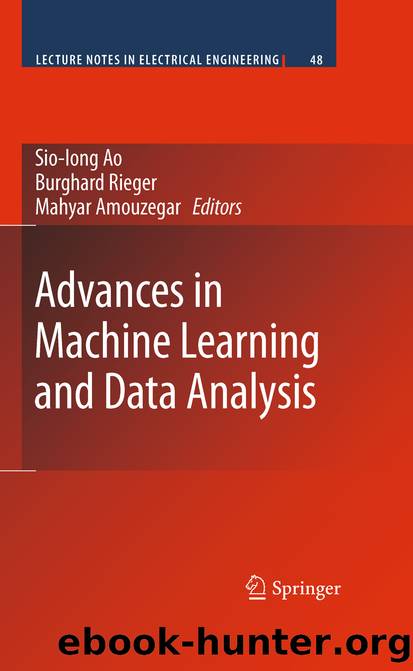Advances in Machine Learning and Data Analysis by Mahyar A. Amouzegar

Author:Mahyar A. Amouzegar
Language: eng
Format: epub
Publisher: Springer Netherlands, Dordrecht
8.2.3 Automatic Photometric Selection of Quasars from the Sloan Digital Sky Survey
Sandage and Wyndham [25] pioneered the selection of quasars from multicolor imaging data and researches on this area continued through the years. The proposed selection algorithm seeks to explore all the regions of color space that quasars are known to occupy. In the work of Richards et al. [22], the quasar candidates were selected via their nonstellar colors in ugriz broadband photometry and by matching unresolved sources to the FIRST radio catalogs. Nearly 95% of previously known quasars were recovered, and the overall completeness is expected to be over 90%. The overall efficiency is better than 65%. The SDSS quasar survey will be approximately four times the size of the concurrent 2dF QSO Redshift Survey [7]. The approach is similar to previous studies, but certain characteristics of the SDSS make the selection of SDSS quasars unique.
Briefly, the proposed algorithm works as follows: (1) Objects with spurious fluxes in the imaging data are rejected. (2) Point-source matches to FIRST radio sources [4] are preferentially targeted without reference to their colors. (3) The sources remaining after the first step are compared to the distribution of normal stars and galaxies in two distinct three-dimensional color spaces. Once quasar candidates were identified, the SDSS fiber-fed spectrographs were used to obtain the spectra of each candidate.
In the color selection process, the first step is to remove from consideration the region inhabited by stars. It is known that the colors of ordinary stars occupy a continuous, almost one-dimensional region in (u − g), (g − r), (r − i), (i − z) color–color–color–color space [20]. As a result of their distinct colors, quasars candidates can be identified as outliers from the stellar locus. The proposed algorithm chooses quasar candidate objects that are more than 4σ from the stellar locus, where σ can be determined from the errors of the objects in question and the width of the stellar locus at the nearest point. The selection is limited to objects fainter than i ∗ = 15. The ugri-selected objects are targeted to i ∗ = 19. 1, while griz-selected objects are targeted to i ∗ = 20. 2. Outliers from the stellar locus are targeted for follow-up spectroscopy.
The completeness of the proposed algorithm is estimated by checking with the recovering of the previously known quasars and the selection of the simulated quasars. A region of about 100 deg2 of sky that has been targeted by the final version of the algorithm has been used to test the efficiency of the algorithm. It is found that 1,113 of the 1,687 quasar candidates with spectra are quasars or AGNs, with an efficiency of 66.0%.
Download
This site does not store any files on its server. We only index and link to content provided by other sites. Please contact the content providers to delete copyright contents if any and email us, we'll remove relevant links or contents immediately.
Algorithms of the Intelligent Web by Haralambos Marmanis;Dmitry Babenko(8517)
Test-Driven Development with Java by Alan Mellor(7336)
Data Augmentation with Python by Duc Haba(7237)
Principles of Data Fabric by Sonia Mezzetta(6982)
Learn Blender Simulations the Right Way by Stephen Pearson(6915)
Microservices with Spring Boot 3 and Spring Cloud by Magnus Larsson(6748)
RPA Solution Architect's Handbook by Sachin Sahgal(6151)
Hadoop in Practice by Alex Holmes(6027)
Jquery UI in Action : Master the concepts Of Jquery UI: A Step By Step Approach by ANMOL GOYAL(5867)
The Infinite Retina by Robert Scoble Irena Cronin(5853)
Big Data Analysis with Python by Ivan Marin(5686)
Life 3.0: Being Human in the Age of Artificial Intelligence by Tegmark Max(5395)
Pretrain Vision and Large Language Models in Python by Emily Webber(4647)
Infrastructure as Code for Beginners by Russ McKendrick(4429)
WordPress Plugin Development Cookbook by Yannick Lefebvre(4159)
Functional Programming in JavaScript by Mantyla Dan(4117)
The Age of Surveillance Capitalism by Shoshana Zuboff(4108)
Embracing Microservices Design by Ovais Mehboob Ahmed Khan Nabil Siddiqui and Timothy Oleson(3948)
Applied Machine Learning for Healthcare and Life Sciences Using AWS by Ujjwal Ratan(3921)
